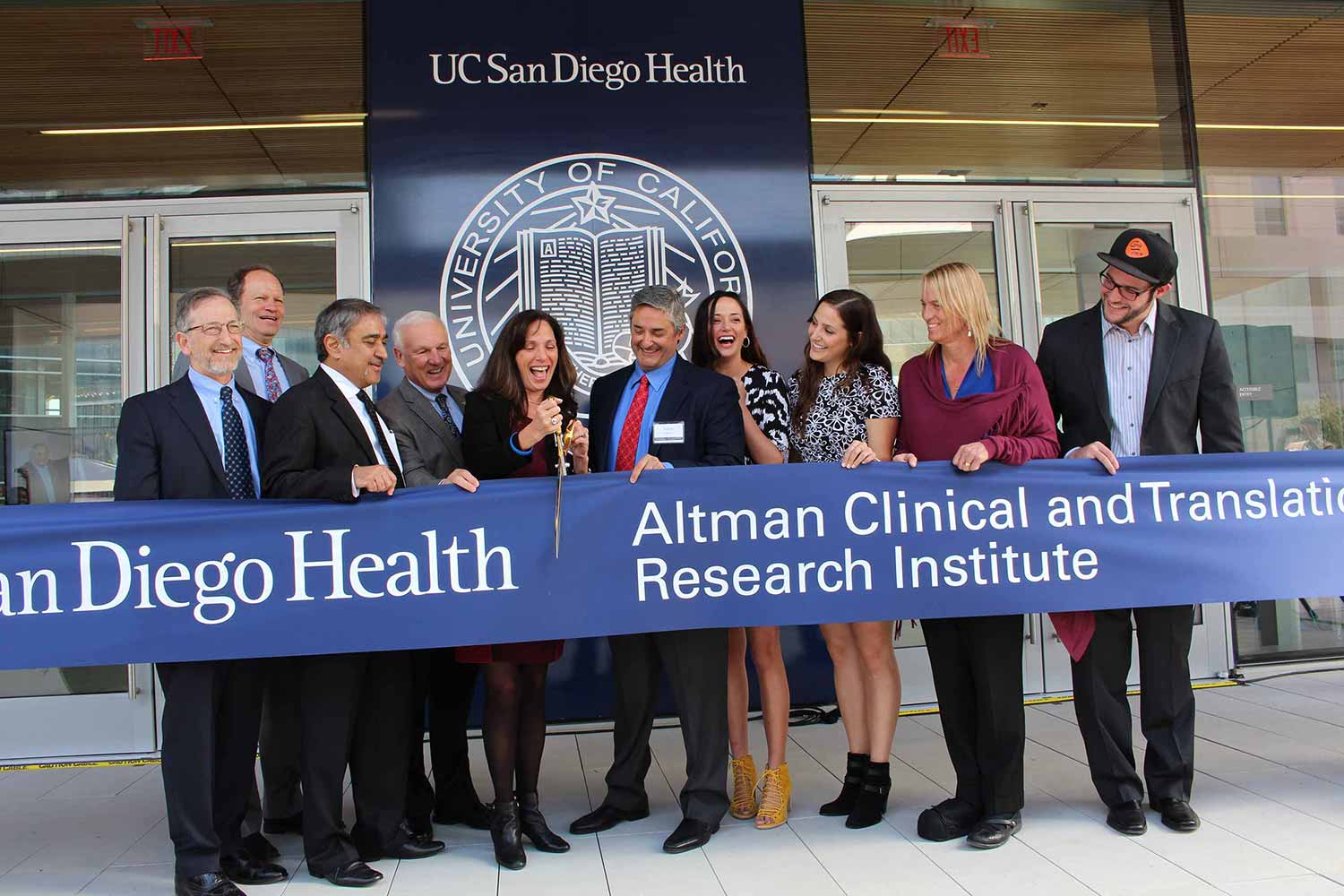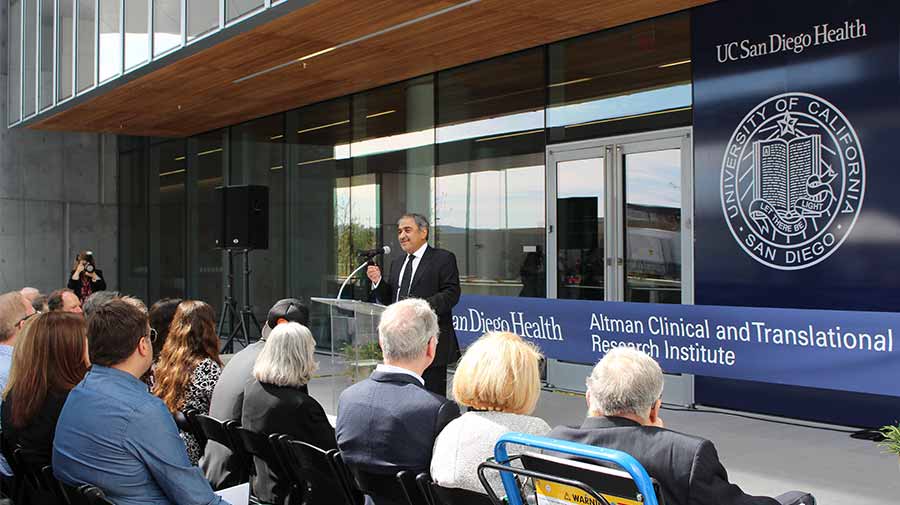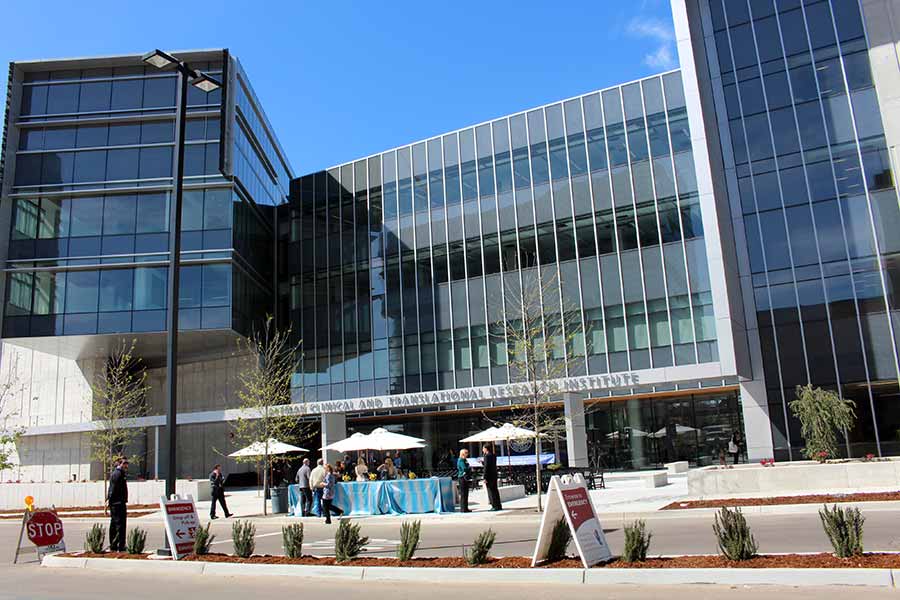By:
- Scott LaFee
Published Date
By:
- Scott LaFee
Share This:

Altman Clinical and Translational Research Building Makes Its Debut
New structure will be campus hub for advancing basic science to clinical applications
Rising above Interstate 5 on the east campus of UC San Diego, the Altman Clinical and Translational Research Institute Building (ACTRI) officially opened its doors Friday in a ribbon-cutting ceremony under blue skies.
The new seven-story building of steel, glass and grooved concrete is home to the Clinical and Translational Research Institute (CTRI) at UC San Diego, established in 2010 as part of a national consortium of 60 medical research institutions created to energize bench-to-bedside efforts.

Chancellor Pradeep K. Khosla describes new ACTRI building as one of the ways UC San Diego will transform health care.
Funded with an initial five-year, $37.2 million grant from the National Center for Advancing Translational Science, part of the National Institutes of Health, the CTRI under Director and Associate Vice Chancellor of Translational Medicine Dr. Gary Firestein, last year garnered a $52 million grant renewal. The new award recognized the institute’s success in creating innovative programs that advance medical science and treatments.
“It’s a spectacular day,” beamed UC San Diego Chancellor Pradeep K. Khosla, nodding at longtime San Diego residents and philanthropists Steve and Lisa Altman. “This couple and what they have helped us to achieve is truly transformative. It changes the way we will deliver healthcare in San Diego and beyond.”
To the Altmans, who donated $10 million in 2011 toward the development and construction of the building, this moment in the sun was perhaps inevitable.
“Type 1 diabetes runs in my family,” said Steve Altman. “My father has it. My brother. Two of my children. Supporting something like this is a no-brainer. The idea that this building and the people in it can help our kids and other families afflicted with all kinds of diseases is something we just had to do.”
Added Lisa, “We’re happy and proud to give something back.”
Indeed, joy and pride were in the air; smiles abounded.
“This enterprise is a shift in paradigm,” said Firestein. “Inside this building will work scientists, doctors, engineers and others, across all disciplines, to develop new drugs, therapies, devices and technologies for patient care. There really is nothing else like it in the country.”
Patty Maysent, CEO of UC San Diego Health, agreed. “We’re creating the environment where no patient will ever have to leave San Diego to get world class health care.“

Seven-story ACTRI building will house multiple institutes, centers and departments in 359,000 square feet of office and lab space.
The ACTRI building will provide infrastructure and support to basic, translational and clinical research throughout the region, conducted by more than 1,000 faculty and institutional partners. It serves as coordinating center for health sciences programs spanning two universities: the School of Medicine and Skaggs School of Pharmacy and Pharmaceutical Sciences at UC San Diego and the schools of Nursing and Public Health at San Diego State University, plus collaborations with Rady School of Management and Jacobs School of Engineering, both at UC San Diego.
The institute helps develop and manage more than 160 clinical trials each year, ranging from sleep studies and stem cell-based therapies to new ways to detect primary breast cancer and early stage Inflammatory Bowel Disease. It provides researchers and institutions with services such as trial design, data analysis and training, with doctoral and community outreach programs in bioinformatics, clinical psychology, communicative disorders and more.
The new building exemplifies growth of clinical and translational science at UC San Diego, both in size and diversity. The structure encompasses 359,000 square feet of offices, state-of-the-art laboratories and clinical space (including a research pharmacy) and will house a multitude of distinct research endeavors. Among them: the Shiley-Marcos Alzheimer’s Disease Research Center, the Alzheimer’s Disease Cooperative Study, the Center for Cannabis Research, the Type 1 Diabetes Research Center, the Musculoskeletal Science Center, the Center for Multimodal Imaging and Genomics and the departments of gastroenterology, hepatology and ophthalmology.
“This is a 21st century lab,” said Dr. David Brenner, Vice Chancellor of Health Sciences and Dean of the UC San Diego School of Medicine.
Last week’s opening proved particularly poignant to San Diego County Supervisor Ron Roberts, who recalled many years earlier traveling with San Diego businessman and former San Diego Padres owner John Moores to Texas to tour a highly regarded research facility.
“We realized years ago that San Diego needed to be doing this,” said Roberts. “We needed to become a translational center, but it didn’t happen at the time. It was disappointing, but this fulfills that dream.”
Share This:
You May Also Like
Stay in the Know
Keep up with all the latest from UC San Diego. Subscribe to the newsletter today.



